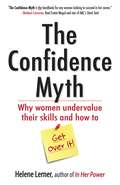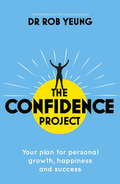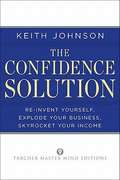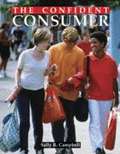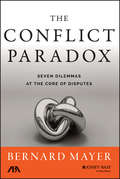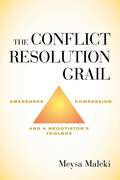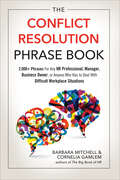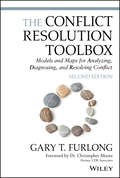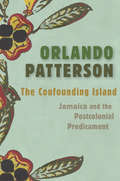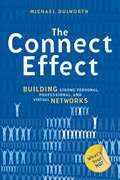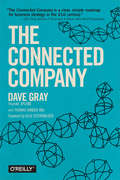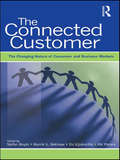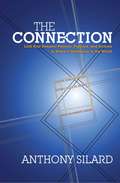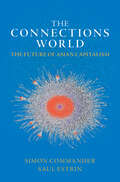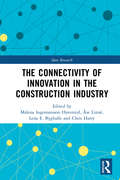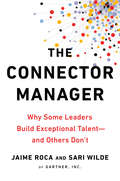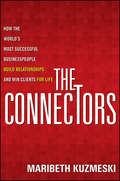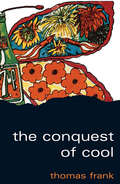- Table View
- List View
The Confidence Myth
by Helene LernerSpeak Out, Step Up, Act NOWNot only do we need more female leaders at the top, but we need more women at all levels of business, government, and nonprofits to step up--there's no time to waste. The problem, says Helene Lerner, isn't so much that women lack confidence but that they misunderstand what confidence really is. True confidence isn't fearlessness; it's having the courage to jump in even when your knees are shaking. Any woman who waits until she feels 100 percent confident before offering a big idea or asking for a raise or promotion will never get anywhere. Drawing on her own and other female leaders' experiences, as well as on her survey of over 500 working women, Lerner lays out practical strategies for beating this confidence myth and overcoming obstacles like gender bias. The book features dozens of Confidence Sparks, simple but powerful exercises and techniques that can catapult anyone's career to the next level.
The Confidence Project: Your plan for personal growth, happiness and success science of self-confidence
by Dr Rob YeungSTART YOUR CONFIDENCE PROJECT NOWFollow the practical advice within the book and undertake THE CONFIDENCE PROJECT; a complete plan for helping you make better decisions and take action in order to fulfil your true potential.Often the only thing separating successful people from the crowd is the self-belief they have running around inside their heads and their innate self-confidence. This book isn't about promoting unrealistic positive thinking - it will help you understand the complex psychology of your beliefs, your assumptions, opinions, values, attitudes, judgements, biases and delusions, and provide a pathway to more confidence.Some of us overestimate ourselves and are overconfident or even unwittingly arrogant and unable to see our flaws. Others underestimate ourselves and are unaware of our full potential. The reality is the most of us overestimate ourselves in some respects and underestimate ourselves in others.This book will open your eyes, doing away with unhelpful beliefs and instilling new, more helpful beliefs about yourself and the world.
The Confidence Solution
by Keith JohnsonIf you were more confident, how would your life be different? This title empowers you to become a confident and successful person by recognizing your inner strengths and talents. Readers will learn how to unlock transformation in their life, exponentially expand their business, quickly shedunwanted weight, and more.
The Confident Consumer
by Sally R. Campbell- The latest information is included on financial planning, legal documents, electronic banking, estate planning, and tax laws. - Many topics have been added to this edition including gross domestic product (GDP), euro, deceptive selling techniques, health care delivery systems, buying or leasing a car, ENERGY STAR label, earth-friendly products, and more.
The Conflict Paradox: Seven Dilemmas at the Core of Disputes
by Bernard S. MayerFind the roadmap to the heart of the conflict The Conflict Paradox is a guide to taking conflict to a more productive place. Written by one of the founders of the professional conflict management field and co-published with the American Bar Association, this book outlines seven major dilemmas that conflict practitioners face every day. Readers will find expert guidance toward getting to the heart of the conflict and will be challenged to adopt a new way to think about the choices disputants face,. They will also be offered practical tools and techniques for more successful intervention. Using stories, experiences, and reflective exercises to bring these concepts to life, the author provides actionable advice for overcoming roadblocks to effective conflict work. Disputants and interveners alike are often stymied by what appear to be unacceptable alternatives,. The Conflict Paradox offers a new way of understanding and working with these so that they become not obstacles but opportunities for helping people move through conflict successfully.. Examine the contradictions at the center of almost all conflicts Learn how to bring competition and cooperation, avoidance and engagement, optimism and realism together to make for more power conflict intervention Deal effectively with the tensions between emotions, and logic, principles and compromise, neutrality and advocacy, community and autonomy Discover the tools and techniques that make conflicts less of a hurdle to overcome and more of an opportunity to pursue Conflict is everywhere, and conflict intervention skills are valuable far beyond the professional and legal realms. With insight and creativity, solutions are almost always possible. For conflict interveners and disputants looking for an effective and creative approach to understanding and working with conflict , The Conflict Paradox provides a powerful and important roadmap for conflict intervention.
The Conflict Resolution Grail: Awareness, Compassion and a Negotiator's Toolbox
by Meysa MalekiGlobal conflict is one of the top challenges the world faces today. Our survival as the human race demands that we pay attention to our own role in conflict. Resolving conflict on a global scale requires change at the level of individuals. Lawyer and Mediator Meysa Maleki introduces the everyday person to the elements of conflict, the sub-conversations and the skills that are required to resolve conflict effectively. However, her solution to addressing human conflict goes beyond just the latest conflict resolution theory, negotiation techniques, and the interpersonal skills of a mediator. She draws on the strengths of human beings, their capacity for compassion and their immense potential to change their subconscious programming through awareness. This book weaves together research ranging from human genetics, evolution, communications theory, neuroscience, world history, psychology, and sociology to reframe our understanding of conflict. It provides the everyday person as well as professionals who devote their careers to working with conflict situations with an integrated approach to conflict resolution. Meysa Maleki provides a new paradigm, one that is based on awareness, compassion, and a negotiator&’s toolbox.
The Conflict Resolution Phrase Book: 2,000+ Phrases For Any HR Professional, Manager, Business Owner, or Anyone Who Has to Deal With Difficult Workplace Situations
by Barbara Mitchell Cornelia GamlemA reference to help business leaders and human resources managers dissolve office disputes and foster dialogue with employees.Ouch! Did I really say that? What was I thinking? It’s uncomfortable to go into a tenuous situation blind and fumbling for words. That’s why people run from conflict.Rather than avoid these situations, The Conflict Resolution Phrase Book can help you prepare for and embrace them. Sometimes you just need a prompt to say the right thing, and that’s what this book will do. Using it you’ll learn:Positive things to say when initiating or responding to difficult conversations and situationsHow to find and craft language to start a sensitive conversationThe right words to positively influence the situationThe more you practice, the better you’ll become. Having this book at your fingertips will give you the confidence that the words will come out right. The Conflict Resolution Phrase Book is a natural complement to the author’s previous book, The Essential Workplace Conflict Handbook.“Barbara and Cornelia take the fear out of managing conflict and difficult conversations.” —Adam Bowman, MA. PHR“A ready resource on how to talk differently to get different results when managing conflict. It is a must have for the manager or HR professional.” —Marsha Hughes-Rease, MSOD, PCC, CAPT/NC/USN/Ret., Quo Vadis Coaching and Consulting, LLC
The Conflict Resolution Toolbox: Models And Maps For Analyzing, Diagnosing, And Resolving Conflict
by Gary FurlongIn real-life conflict resolution situations, one size does not fit all. Just as a mechanic does not fix every car with the same tool, the conflict resolution practitioner cannot hope to resolve every dispute using the same technique. Practitioners need to be comfortable with a wide variety of tools to diagnose different problems, in vastly different circumstances, with different people, and resolve these conflicts effectively. The Conflict Resolution Toolbox gives you all the tools you need: eight different models for dealing with the many conflict situations you encounter in your practice. This book bridges the gap between theory and practice and goes beyond just one single model to present a complete toolbox - a range of models that can be used to analyze, diagnose, and resolve conflict in any situation. It shows mediators, negotiators, managers, and anyone needing to resolve conflict how to simply and effectively understand and assess the situations of conflict they face. And it goes a step further, offering specific, practical guidance on how to intervene to resolve the conflict successfully. Each model provides a different and potentially useful angle on the problem, and includes worksheets and a step-by-step process to guide the reader in applying the tools. Offers eight models to help you understand the root causes of any conflict. Explains each model's focus, what kind of situations it can be useful in and, most importantly, what interventions are likely to help. Provides you with clear direction on what specific actions to choose to resolve a particular type of conflict effectively. Features a detailed case study throughout the book, to which each model is applied. Additional examples and case studies unique to each chapter give the reader a further chance to see the models in action. Includes practical tools and worksheets that you can use in working with these models in your practice. The Conflict Resolution Toolbox equips any practitioner to resolve a wide range of conflicts. Mediators, negotiators, lawyers, managers and supervisors, insurance adjusters, social workers, human resource and labour relations specialists, and others will have all the tools they need for successful conflict resolution.
The Conflict Resolution Toolbox: Models and Maps for Analyzing, Diagnosing, and Resolving Conflict
by Gary T. FurlongIn real-life conflict resolution situations, one size does not fit all. Just as a mechanic does not fix every car with the same tool, the conflict resolution practitioner cannot hope to resolve every dispute using the same technique. Practitioners need to be comfortable with a wide variety of tools to diagnose different problems, in vastly different circumstances, with different people, and resolve these conflicts effectively. The Conflict Resolution Toolbox gives you all the tools you need: eight different models for dealing with the many conflict situations you encounter in your practice. This book bridges the gap between theory and practice and goes beyond just one single model to present a complete toolbox - a range of models that can be used to analyze, diagnose, and resolve conflict in any situation. It shows mediators, negotiators, managers, and anyone needing to resolve conflict how to simply and effectively understand and assess the situations of conflict they face. And it goes a step further, offering specific, practical guidance on how to intervene to resolve the conflict successfully. Each model provides a different and potentially useful angle on the problem, and includes worksheets and a step-by-step process to guide the reader in applying the tools. Offers eight models to help you understand the root causes of any conflict. Explains each model's focus, what kind of situations it can be useful in and, most importantly, what interventions are likely to help. Provides you with clear direction on what specific actions to choose to resolve a particular type of conflict effectively. Features a detailed case study throughout the book, to which each model is applied. Additional examples and case studies unique to each chapter give the reader a further chance to see the models in action. Includes practical tools and worksheets that you can use in working with these models in your practice. The Conflict Resolution Toolbox equips any practitioner to resolve a wide range of conflicts. Mediators, negotiators, lawyers, managers and supervisors, insurance adjusters, social workers, human resource and labour relations specialists, and others will have all the tools they need for successful conflict resolution.
The Conflict Resolution Toolbox: Models and Maps for Analyzing, Diagnosing, and Resolving Conflict
by Gary T. FurlongPRAISE FOR THE CONFLICT RESOLUTION TOOLBOX SECOND EDITION "I have been using and recommending The Conflict Resolution Toolbox since its first edition. It is rare to find a resource with such practical tools in a field that is so concrete, but often struggles to bridge theory and practice. In this increasingly complex world, it is vital to have models to resort to when we reach impasse in conflict. I recommend The Conflict Resolution Toolbox to anyone engaged in resolving conflicts in any discipline." —Martha E. Simmons, JD, LLM, PHD, Academic Director, Winkler Institute of Dispute Resolution and Director, Mediation Clinic and Intensive Program, Toronto, Canada "We all know one thing about conflict: It is messy! Furlong's models offer mediators, facilitators, lawyers, psychotherapists and others 'a leg up' in more swiftly figuring out what is going on and what is needed. Furlong does not offer up a single 'truth', style or theory, so much as a collection of effective tools that professionals, groups and families can use to better understand what they are experiencing and how they can approach achieving better results. Highly recommended!" —James C. Melamed, JD, CEO, Mediate.com "Gary Furlong has done it again! A long-time leader in the conflict resolution field, Gary has added two new 'power tools' to what was already the essential conflict resolution toolkit. His new chapters in this Second Edition deal with 'The Law of Reciprocity' and 'Loss Aversion Bias'. I am proud and thankful to add this book to my already growing conflict resolution bookcase, knowing that this is a volume I will go to again and again. I highly recommend it for anyone in the field." —Rick Weiler, Mediator, Arbitrator, Weiler ADR Inc., Ottawa, Canada "Gary Furlong uniquely provides invaluable, practical tools that help in understanding, preventing, and resolving conflict. This is a must-have reference book for anyone who cares about mitigating the role destructive conflict plays in our professional and personal lives and finding strategic benefit in tools that work. Gary has created a book that is both aspirational and practical. It's so challenging to create simple-to-use tools supported by complex concepts and Gary does this better than anyone." —Joshua A. Gordon, JD, MA, Arbitrator for the Court of Arbitration of Sport, Senior Practitioner at the Sports Conflict Institute, and Woodard Family Foundation Fellow Senior Instructor of Sports Business at the University of Oregon Lundquist College of Business
The Confounding Island: Jamaica and the Postcolonial Predicament
by Orlando PattersonOrlando Patterson returns to Jamaica, his birthplace, to reckon with its history and culture. Locals claim to be some of the world’s happiest people, and their successes in music and athletics are legendary. Yet the country remains violent and poor. In Jamaica the dilemmas of globalization and postcolonial politics are thrown into stark relief.
The Congressional Oversight Panel's Valuation of the TARP Warrants (A)
by Carliss Y. BaldwinThe Congressional Oversight Panel wants to value the warrants issued to the government in connection with the TARP investments of 2008, in order to increase the transparency of options repurchases. The case describes the methodology used to value the warrants. Students have the opportunity to value warrants issued by 10 of the largest banks and to evaluate whether the Black-Scholes model can be used to value these very long-lived 10 options. Can be used to teach basic option valuation using Black-Scholes, but also raise dynamic hedging issues of interest to advanced students.
The Connect Effect: Building Strong Personal, Professional, and Virtual Networks
by Michael DulworthEmployment consultant Dulworth instructs how to take a conscious, systematic approach to networking in order to improve personal and professional development skills. After a brief introduction explaining the importance and benefits of networking, he presents a quiz for the reader to determine networking quotient. He then identifies three kinds of networks--personal, professional, and virtual--and examines each for their specific characteristics, further offering strategies, tools, and resources for increasing and making the best use of each network. Two resource-oriented appendices include information on forming a person board for decision-making, and online networking sites. Annotation ©2008 Book News, Inc. , Portland, OR (booknews. com)
The Connected Company
by Dave Gray Thomas Vander Wal<p>To keep pace with today’s connected customers, your company must become a connected company. That means deeply engaging with workers, partners, and customers, changing how work is done, how you measure success, and how performance is rewarded. It requires a new way of thinking about your company: less like a machine to be controlled, and more like a complex, dynamic system that can learn and adapt over time. <i>The Connected Company</i> shows you how.</p>
The Connected Company
by Dave Gray Thomas Vander WalWith a foreword by Alex Osterwalder.The future of work is already here.Customers are adopting disruptive technologies faster than your company can adapt. When your customers are delighted, they can amplify your message in ways that were never before possible. But when your company’s performance runs short of what you’ve promised, customers can seize control of your brand message, spreading their disappointment and frustration faster than you can keep up.To keep pace with today’s connected customers, your company must become a connected company. That means deeply engaging with workers, partners, and customers, changing how work is done, how you measure success, and how performance is rewarded. It requires a new way of thinking about your company: less like a machine to be controlled, and more like a complex, dynamic system that can learn and adapt over time.Connected companies have the advantage, because they learn and move faster than their competitors. While others work in isolation, they link into rich networks of possibility and expand their influence.Connected companies around the world are aggressively acquiring customers and disrupting the competition. In The Connected Company, we examine what they’re doing, how they’re doing it, and why it works. And we show you how your company can use the same principles to adapt—and thrive—in today’s ever-changing global marketplace.
The Connected Customer: The Changing Nature of Consumer and Business Markets
by Stefan Wuyts Marnik G. Dekimpe Els Gijsbrechts Rik PieteIn today’s connected consumer environment, customers are better informed and harder to please, but they also leave a more visible evidence trail in the form of improved databases and customer information. Consumers are increasingly interconnected through various sorts of social networks, a trend that is facilitated by recent advances in electronic media and telecommunication (i.e., MySpace, Facebook, Twitter and Cyworld). Consumers are also increasingly connected with brands and seek to play a more participative role in their relationship with companies, stimulating companies to reconsider how to connect with consumers. This book consists of a collection of chapters by thought-leaders in the field of marketing and beyond that deals with the rich facets of connectivity. This edited volume is a great source of research ideas and fresh theory building for academics and students in marketing and related fields who wish to understand this exciting field. It will be a source of inspiration for practitioners who are eager to take up the challenge and adapt their marketing strategies to the changing nature of consumer and business markets.
The Connection
by Anthony SilardIn this landmark book, leadership guru Anthony Silard takes a holistic view of success that makes sense in a modern world. With the proliferation of texting, emails, smart phones, and more, our home lives have begun to look a lot like work and now, more than ever, people crave deep connections and fulfillment in both their personal and professional lives. The Connection provides ways to handle the unprecedented information flow, increased loneliness, and lack of purpose that so often characterize modern culture. The Connection is a valuable resource for people who wish to live with value and purpose and develop a more centered, directed, and resilient approach to life.With a simple set of exercises, Silard shows you how to bring worth and drive to every aspect of your life by transforming your lofty dreams into concrete, deadline-driven goals that align your deepest values with your everyday existence. Silard will help you understand the true source of your passion and motivation to build a foundation for change, and, ultimately, the skills to cultivate a truly authentic life.The Connection includes dozens of specific tools and strategies, all enhanced with personal examples, inspiring quotes, and insightful anecdotes to offer an entertaining and life-changing read.
The Connection: Link Your Deepest Passion, Purpose, and Actions to Make a Difference in the World
by Anthony SilardIn this landmark book, leadership guru Anthony Silard takes a holistic view of success that makes sense in a modern world. With the proliferation of texting, emails, smart phones, and more, our home lives have begun to look a lot like work and now, more than ever, people crave deep connections and fulfillment in both their personal and professional lives. The Connection provides ways to handle the unprecedented information flow, increased loneliness, and lack of purpose that so often characterize modern culture. The Connection is a valuable resource for people who wish to live with value and purpose and develop a more centered, directed, and resilient approach to life.With a simple set of exercises, Silard shows you how to bring worth and drive to every aspect of your life by transforming your lofty dreams into concrete, deadline-driven goals that align your deepest values with your everyday existence. Silard will help you understand the true source of your passion and motivation to build a foundation for change, and, ultimately, the skills to cultivate a truly authentic life.The Connection includes dozens of specific tools and strategies, all enhanced with personal examples, inspiring quotes, and insightful anecdotes to offer an entertaining and life-changing read.
The Connections World: The Future of Asian Capitalism
by Simon Commander Saul EstrinA central feature of modern Asia that trumps differences in economic and political systems is the web of close relationships running between and within business and politics; the connections world. These networks facilitate highly transactional interactions yielding significant reciprocal benefits. Although the connections world has not as yet seriously impeded Asia's economic renaissance, it comes with significant costs and fallibilities. These include the creation and entrenchment of huge market power and the attenuation of competition. They in turn hold back the growth in productivity and innovation that will be essential for further development. The connections world also breeds massive inequalities that may culminate in political instability. The authors argue that if Asia's claim to the 21st century is not to be derailed, major changes must be made to policy and behaviour so as to cut away the foundations of the connections world and promote more sustainable economic and political systems.
The Connectivity of Innovation in the Construction Industry (Spon Research)
by Malena Ingemansson Havenvid Åse Linné Lena E. Bygballe Chris HartyThe construction industry is currently experiencing accelerating developments concerning societal demands along with project complexity, internationalization and digitalization. In an attempt to grasp the consequences of these demands on productivity and innovation, this edited book addresses how innovation is likely to take place with a more long-term perspective on the construction sector. While existing literature focuses on organizational discontinuity and fragmentation as the main reasons for the apparent lack of innovation in the industry, this book highlights the connectivity of construction actors, resources and activities as fundamental for understanding how innovation takes place.Through 15 empirically grounded chapters, the book shows how innovation is part of construction processes on various levels, including project, firm and industry, and that these innovation processes are characterized by organizational and technological connectivity over time. Written by European business management scholars, the chapters cover empirical cases and examples from both a multi-organizational and a multi-international perspective in terms of covering the viewpoints of different industry actors and the contexts of several different European countries including: Sweden, Norway, the UK, Italy, France, Hungary and Poland. By illustrating how connectivity is part of innovation processes in the creation of single-product innovations, of various innovations within and across projects, as well as a fundamental aspect of the processes in which innovations cross nations, the book provides a new angle on how to understand construction innovation and where the industry might (or needs to) be heading next. This book is essential reading for anyone interested in construction management, project management, engineering management, innovation studies, business and management studies.
The Connector Manager: Why Some Leaders Build Exceptional Talent - and Others Don't
by Jaime Roca Sari WildeThere are four distinct types of managers. One performs much worse than the rest, and one performs far better. Which type are you?Based on a first-of-its-kind, wide-ranging global study of over 9,000 people, analysts at the global research and advisory firm Gartner were able to classify all managers into one of four types: • Teacher managers, who develop employees' skills based on their own expertise and direct their development along a similar track to their own. • Cheerleader managers, who give positive feedback while taking a general hands-off approach to employee development. • Always-on managers, who provide constant, frequent feedback and coaching on all aspects of the employee's performance. • Connector managers, who provide feedback in their area of expertise while connecting employees to others in the team or organization who are better suited to address specific needs.Although the four types of managers are more or less evenly distributed, the Connector manager consistently outperforms the others by a significant margin. Meanwhile, Always-on managers tend to see their employees struggle to grow within the organization. Why is that?Drawing on their groundbreaking data-driven research, as well as in-depth case studies and extensive interviews with managers and employees at companies like IBM, Accenture, and eBay, the authors show what behaviors define a Connector manager, and why they are able to build powerhouse teams. They also show why other types of managers fail to be equally effective, and how they can incorporate behaviors of Connector managers in order to be more effective at building teams.
The Connectors
by Maribeth KuzmeskiLearn the relationship-building secrets that lead to lifelong clients, repeat customers, and endless referralsIn today's commoditized marketplace, no matter what product or service you sell, there's probably someone somewhere able to offer it cheaper, faster, and maybe even better. So how do you differentiate yourself from your competitors? The Connectors shows that the only thing that truly sets you apart is the quality of your relationships with your clients and customers.Everyone knows that relationships are important in business. Yet most people would admit that their relationships could be better--but don't spend time working on the underlying skills. This book explains how to develop better, more profitable connections--as illustrated proven by some of the world's most successful professionals. Even if you're not a "people person," you can dramatically grow your business or your career through a few simple approaches to relationship-building.The Connectors presents a five-step methodology that lead to lifelong clients, repeat customers, and endless referrals. Inside, you'll learn how to:Stop networking and start truly connectingCreate an avalanche of referrals and an army of happy customersBecome a "connector," even if you've never been a "people person"Find your social IQ--and improve itPut relationship-building principles to work dailyFocus on others and reap the rewards yourselfAsk the right questions--and sell without sellingDifferentiate yourself through the impact you have on othersIn The Connectors, Maribeth Kuzmeski, founder of Red Zone Marketing, LLC, and consultant to Fortune 500 firms, shows you how to build profitable, long-lasting business relationships.
The Conquest of Cool: Business Culture, Counterculture, and the Rise of Hip Consumerism
by Thomas FrankWhile the youth counterculture remains the most evocative and best-remembered symbol of the cultural ferment of the 1960s, the revolution that shook American business during those boom years has gone largely unremarked. In this revealing book, Thomas Frank shows how the youthful revolutionaries were joined--and even anticipated --by such unlikely allies as the advertising industry and the men's clothing business.
The Conquest of Cool: Business Culture, Counterculture, and the Rise of Hip Consumerism
by Thomas FrankWhile the youth counterculture remains the most evocative and best-remembered symbol of the cultural ferment of the 1960s, the revolution that shook American business during those boom years has gone largely unremarked. In this fascinating and revealing study, Thomas Frank shows how the youthful revolutionaries were joined—and even anticipated —by such unlikely allies as the advertising industry and the men's clothing business. "[Thomas Frank is] perhaps the most provocative young cultural critic of the moment."—Gerald Marzorati, New York Times Book Review "An indispensable survival guide for any modern consumer."—Publishers Weekly, starred review "Frank makes an ironclad case not only that the advertising industry cunningly turned the countercultural rhetoric of revolution into a rallying cry to buy more stuff, but that the process itself actually predated any actual counterculture to exploit."—Geoff Pevere, Toronto Globe and Mail "The Conquest of Cool helps us understand why, throughout the last third of the twentieth century, Americans have increasingly confused gentility with conformity, irony with protest, and an extended middle finger with a populist manifesto. . . . His voice is an exciting addition to the soporific public discourse of the late twentieth century."—T. J. Jackson Lears, In These Times "An invaluable argument for anyone who has ever scoffed at hand-me-down counterculture from the '60s. A spirited and exhaustive analysis of the era's advertising."—Brad Wieners, Wired Magazine "Tom Frank is . . . not only old-fashioned, he's anti-fashion, with a place in his heart for that ultimate social faux pas, leftist politics."—Roger Trilling, Details
The Conscience Code: Lead with Your Values. Advance Your Career.
by G. Richard ShellThe essential guide to standing up for your values at work. Protect your integrity by committing to The Conscience Code.A fast-track colleague elbowing their way up the corporate ladder in your organization is faking their sales reports. Your entrepreneur boss asks you to lie to would-be investors. The team leader is a serial sexual harasser. What should you do? Nobody prepared you for this part of professional life. You face a gut-wrenching choice: &“go along to get along&” or risk your job by speaking up for what you know is right.At the Wharton School of Business, MBA students have shared all these stories, and many more, with award-winning Professor G. Richard Shell. They want to stay true to themselves but fear the consequences of speaking up—for their families, office relationships and, ultimately, their careers. They are not alone. Surveys show that more than 40% of employees report seeing ethical misconduct at work, and most fail to report it—killing office morale and allowing the wrong people to set the example.Shell created The Conscience Code to point to a better path: recognize that these conflicts are coming, learn to spot them, then follow a research-based, step-by-step approach for resolving them skillfully. By committing to the Code, you can replace regret with long-term career success as a leader of conscience.The Conscience Code:Solves a crucial problem faced by professionals everywhere: What should they do when they are asked to compromise their core values to achieve organizational goals?Teaches readers to recognize and overcome the five organizational forces that push people toward actions they later regret.Lays out a systematic, values-to-action process that people at all levels can follow to maintain their integrity while achieving true success in their lives and careers.Driven by dramatic, real-world examples from Shell&’s classroom, today&’s headlines, and classic cases of corporate wrongdoing, The Conscience Code shows how to create value-based workplaces where everyone can thrive.
